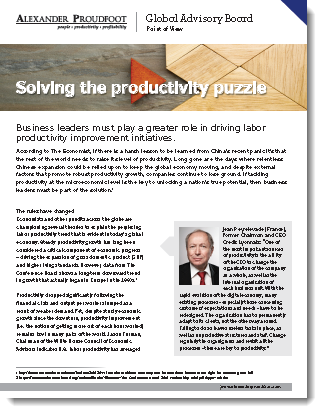
According to The Economist, if there is a harsh lesson to be learned from China’s recent panic it’s that the rest of the world needs to raise its level of productivity. Long gone are the days where relentless Chinese expansion could be relied upon to keep the global economy moving, and despite external factors that promote robust productivity growth, companies continue to lose ground. If tackling productivity at the microeconomic level is the key to unlocking a nation’s true potential, then business leaders must be part of the solution.
Labor productivity is a key determinant of overall performance and a top priority for chief executives looking to realize the full potential of their respective organizations. However, most businesses claim to be unsatisfied with their level of productivity. Our findings show that executives are generally aware that untapped opportunities exist, but have trouble finding or leveraging them.
Managing the talent pool
Given the speed at which markets are evolving, effectively managing talent will allow a company to grow. Investing in human capital to develop skills, capacity, flexibility and adaptability creates a solid foundation for developing a long-term competitive advantage. Today’s severely depleted talent pool is a serious issue across multiple markets and sectors.
Innovation
Product innovation is a widely acknowledged, powerful driver of growth. Companies across developed economies that compete against organizations with lower cost structures can leverage new products or innovation in order to stimulate growth.
Management's role
Skilled workers often have the capacity to do more when they are allowed to concentrate on tasks that require their unique skills. The trick is to eliminate those non-value added tasks that limit the capacity of the more highly skilled technicians. It is management’s responsibility to make sure that people with unique skills are utilized properly.
In a recent roundtable discussion, members of Alexander Proudfoot's Advisory Board weighed in on leadership's responsibility to drive productivity. Here are some of their responses:
Bill Johnson (USA), former CEO HJ Heinz: “Despite the current downturn, there are ways to increase output. It often requires a cultural transformation – one that requires change on every level of the organization – to make it happen. Getting people to buy in to your plan and behave a certain way takes a significant amount of time and energy.
Mike Critelli (USA), former CEO Pitney Bowes: “Productivity improvements invariably require many individuals to change the way they work, often with some perceived risk to their continued employment. Few people will voluntarily make such changes. CEO leadership and focus are needed to ensure that these adjustments take place, and that they are sustained - painting a clear picture as to why work process changes will benefit the company and its employees.”
Jean Peyrelevade (France), former Chairman and CEO Credit Lyonnais: “One of the most important sources of productivity is the ability of the CEO to change the organization of the company as a whole, as well as the internal organization of each business unit. With the rapid evolution of the digital economy, many existing processes - especially those concerning customers’ expectations and needs - have to be redesigned. The organization has to permanently adapt to its clients, not the other way around.
To see what other C-level executives had to say about today's decline of productivity in the workplace, click here.
You may also like...
 |
 |
 |

